

Home
About Us
Allotments
Garden Equipment
Seed Suppliers
Manure Problems
Solve It - Puzzles
Children's Pages
GLA Blog
Weather Blog
School Veg Patch
Useful Links
Weather Blog
Garden Video Blog
Frog
These are really very welcome on our plots and in our gardens – they do no harm and are a real asset to us as a means of biological control.
Unlike a toad the Common Frog has a smooth skin which is grey, green, yellow or brown and patterned with darker blotches. The legs are ringed and the face has darker mask like markings. Frogs can lighten or darken the colour of their skin to enable them to merge more successfully into their surroundings.
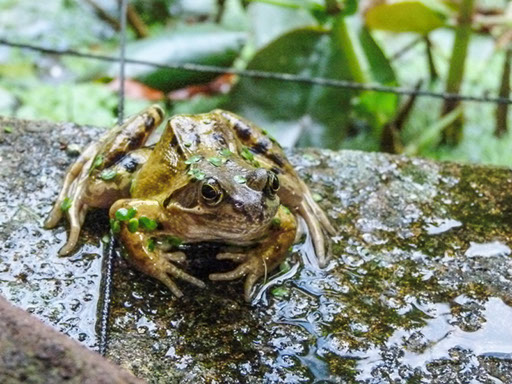
They have very good eyesight. Their eyes being positioned on top of the head means that they can poke them just above water whilst the rest of their body remains submerged. The eyes also bulge out which means that frogs can see in most directions even though they can’t move their eyes within the sockets as we and many other animals can. Most frogs have a thin membrane, or lower eyelid, that covers the eye and protects it when under water.
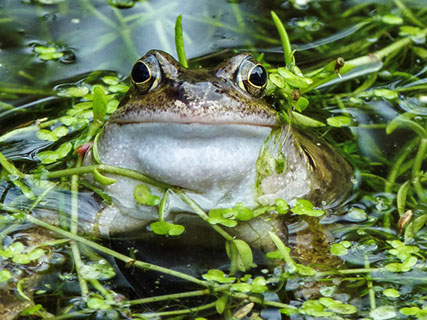
During the breeding season, (February and March), when a frog’s mind turns to things other than its stomach, Common Frogs do not feed at all. When all the activity is over, however, they will feed on just about any moving creepy crawly that they can get their mouths around. Some of their snacks are exactly the type of creature that we want to control in our garden such as slugs and snails.
Having webbed hind feet frogs are strong swimmers. They also have powerful hind legs which make them excellent at jumping – in effect they are all-round athletes. The front feet have toes without webbing which enable them to hold on to the larger females during mating.
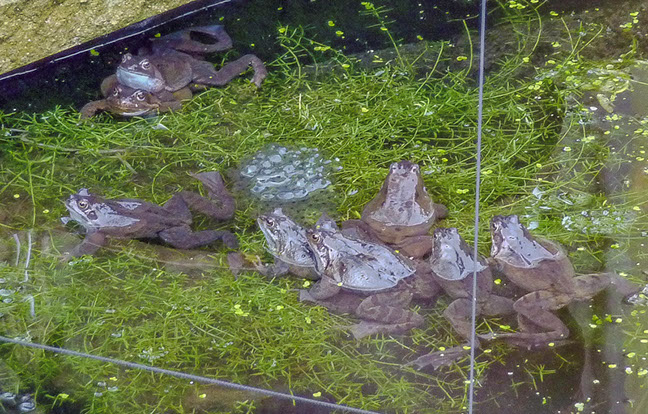
In the mating season the females are in great demand and so once a male has found his female it is important he hangs on tightly to her for several days or even weeks. His front fingers are even specially adapted to provide a stronger grip.
Other male frogs will try and dislodge him and often the poor female will be submerged under a pile of males. Some will drown as a result.
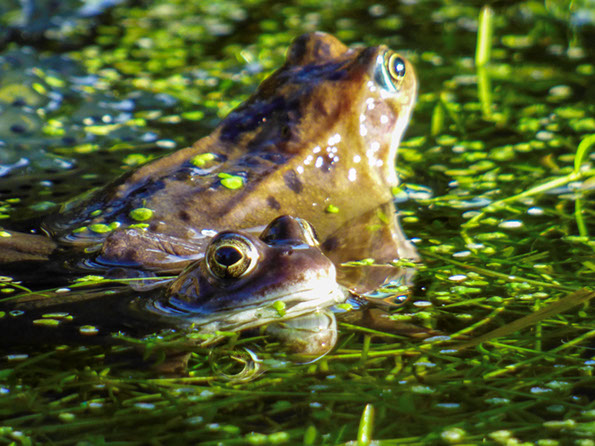
The female can release up to 4000 eggs so it is likely that they could be fertilised by more than one attending male! This many seem rather a lit of eggs but few will end up as fully grown frogs as the mortality rate is very high.
Frogs tend to use their sense of smell to return to the water in which they spawned in order to breed. The males will arrive first and begin making a low croaking sound in order to attract the females. As the common frog lacks the voice sac that is a feature of some other types of frog, its croaking does not carry far.
Frog spawn is found in masses – a bit like sago pudding – floating on the surface of water whereas the spawn of toads is deposited in long strings wrapped around pond weed and that of the newt attached singly to a leaf. We have observed a cluster of frogs seeming to guard the spawn.
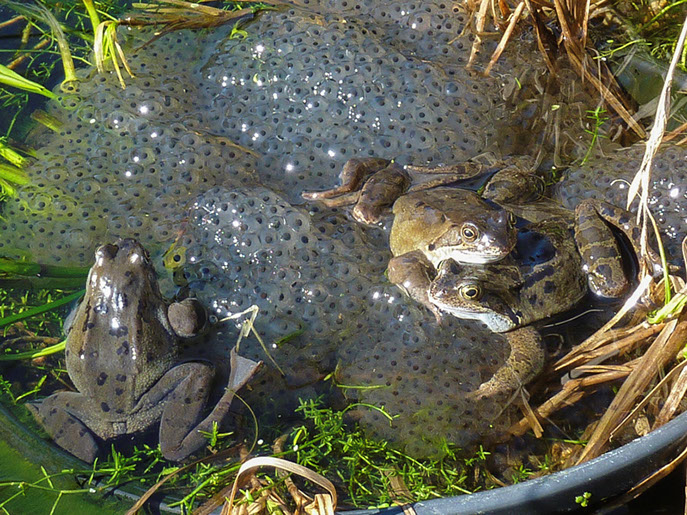
Tadpoles gradually develop into tadpoles that feed on the jelly until they become free swimming when at first they browse plants and algae.
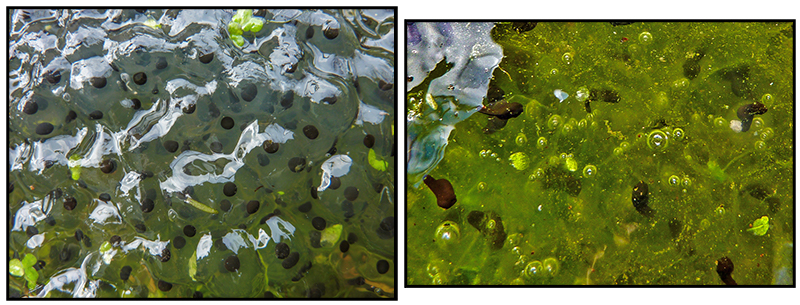
Once the tadpoles are free swimming it is difficult to photograph them,. As the tadpoles develop legs they start to feed on minute animal organisms. At this stage they also need to breathe air. Eventually they leave the water as small versions of their parents.
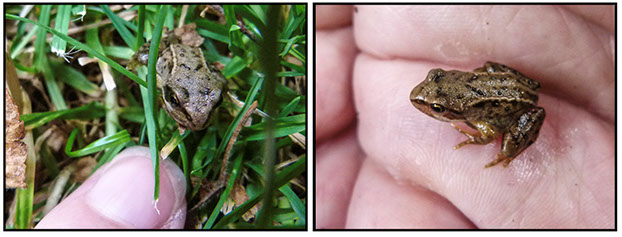
The Common Frog doesn’t chase its prey. It lays in wait for a suitably sized unsuspecting victim to come along and then flicks out its sticky tongue to catch and reel it in. Adult frogs only feed on land and will only eat living prey. (I suppose it is rather difficult to lie in wait until a dead creature happens to pass by!) As a frog cannot chew it must swallow its prey whole. To help manage its meal a frog will blink or close its eyes The closed eyes sink through openings in the frog’s skull and help to push the meal down.
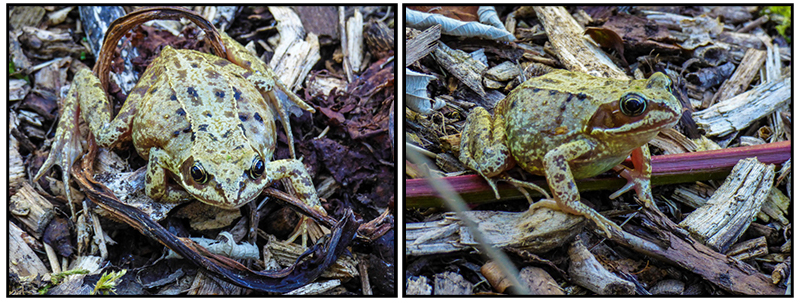
Although Common Frogs are more active at night, they are also active at all times of the day. In winter they hibernate under stones, piles of dead leaves, logs or in compost heaps. We once found a frog hibernating in the frog of an old brick. (the hollowed part of the brick). It made me wonder if this was why this part of the brick was so called – anyone know the answer? As frogs can breathe through their skin, they can also hibernate in the mud at the bottom of ponds.
One thing that did surprise me is how well a frog can climb.
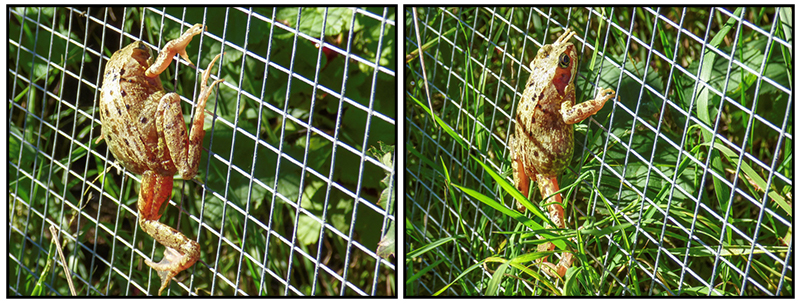
A frog can live up to eight years in the wild if it doesn’t succumb to the many froggy hazards. Frogs are part of the menu for many larger creatures such as owls, kestrels, herons, weasels, otters, pine martens, badgers, foxes, grass snakes and pike. They also often fall prey to rats – it seems that there is no hiding place as they can come under attack from the air, from land or in the water.
Other than being eaten by a predator the frog is also under threat from the loss of its habitat. The increase in the number of garden ponds has provided a much needed boost to the frog population.
Another threat comes from a fungus which in turn causes a disease in frogs called chytridiomycosis. (I have absolutely no idea how to pronounce this!) At the moment it is uncertain how serious a problem this is likely to be to frogs in the UK, although in Australia and America, it has had a devastating effect on amphibian populations.
If that wasn't enough to contend with, water pollution badly affects frogs and many are killed on the roads that they must cross as they head for their breeding grounds oblivious of the oncoming traffic.
Our Plot at Green Lane Allotments Blog | A Gardener's Weather Diary | School Vegetable Patch Website
© Our Plot on Green Lane Allotments - Please email me if you wish to use any of this site's content